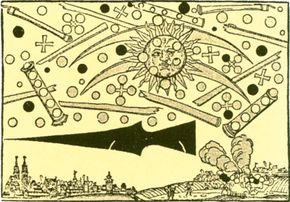Ancient and Medieval UFOs
In A.D. 1211 Gervase of Tilbury, an English chronicler of historical events and curiosities, recorded this bizarre story:
This tale -- unrelated to any other British legend or supernatural tradition -- is, according to folklorist Katharine Briggs, "one of those strange, unmotivated and therefore rather convincing tales that are scattered through the early chronicles."
Advertisement
In a 9th-century Latin manuscript, Liber contra insulam vulgi opinionem, the Archbishop of Lyons complained about the French peasantry's insistent belief in a "certain region called Magonia from whence come ships in the clouds." The occupants of these vessels "carry back to that region those fruits of the earth which are destroyed by hail and tempests; the sailors paying rewards to the storm wizards and themselves receiving corn and other produce." The archbishop said he had even witnessed the stoning to death of "three men and a woman who said they had fallen from these same ships." Jakob Grimm, a 19th-century folklorist, speculated, "'Magonia' takes us to some region where Latin was spoken, if we may rely on it referring to Magus, i.e., a magic land."
Are these early references to UFOs and aliens? Possibly. But references of this sort are few and far between. Although ancient and medieval records are filled with stories of strange shapes and figures in the sky, little in these accounts elicits visions of UFOs as we understand them today. Many eerie aerial phenomena of an earlier time can now be identified as meteors, comets, and auroral displays.
